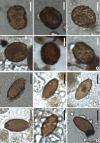1. Ferreira LF, Reinhard KJ, Araújo AJ. Fundamentos da Paleoparasitologia. Rio de Janeiro, Brazil: Editora Fiocruz;2011.
2. Reinhard K, Araújo A. Archaeoparasitology. In : Pearsall DM, editor. Encyclopedia of Archaeology. San Diego, CA: Academic Press;2008. p. 494–591.
3. Seo M, Araujo A, Reinhard K, Chai JY, Shin DH. Paleoparasitological studies on mummies of the Joseon Dynasty, Korea. Korean J Parasitol. 2014; 52(3):235–242.

4. Bouchet F, Baffier D, Girard M, Morel P, Paicheler JC, David F. Paléoparasitologie en contexte pléistocène: premières observations à la Grande Grotte d'Arcy-sur-Cure (Yonne), France. C R Acad Sci III. 1996; 319(2):147–151.
5. Evans AC, Markus MB, Mason RJ, Steel R. Late stone-age coprolite reveals evidence of prehistoric parasitism. S Afr Med J. 1996; 86(3):274–275.
6. Gonçalves ML, Araújo A, Ferreira LF. Human intestinal parasites in the past: new findings and a review. Mem Inst Oswaldo Cruz. 2003; 98:Suppl 1. 103–118.

7. Seo M, Guk SM, Kim J, Chai JY, Bok GD, Park SS, et al. Paleoparasitological report on the stool from a medieval child mummy in Yangju, Korea. J Parasitol. 2007; 93(3):589–592.

8. Seo M, Shin DH, Guk SM, Oh CS, Lee EJ, Shin MH, et al. Gymnophalloides seoi eggs from the stool of a 17th century female mummy found in Hadong, Republic of Korea. J Parasitol. 2008; 94(2):467–472.
9. Seo M, Oh CS, Chai JY, Lee SJ, Park JB, Lee BH, et al. The influence of differential burial preservation on the recovery of parasite eggs in soil samples from Korean medieval tombs. J Parasitol. 2010; 96(2):366–370.

10. Shin DH, Lim DS, Choi KJ, Oh CS, Kim MJ, Lee IS, et al. Scanning electron microscope study of ancient parasite eggs recovered from Korean mummies of the Joseon Dynasty. J Parasitol. 2009; 95(1):137–145.

11. Shin DH, Oh CS, Lee SJ, Lee EJ, Yim SG, Kim MJ, et al. Ectopic paragonimiasis from 400 year old female mummy of Korea. J Archaeol Sci. 2012; 39(4):1103–1110.
12. Seo M, Chai JY, Kim MJ, Shim SY, Ki HC, Shin DH. Detection trend of helminth eggs in the strata soil samples from ancient historic places of Korea. Korean J Parasitol. 2016; 54(5):555–563.

13. Lee WJ, Woo EJ, Oh CS, Yoo JA, Kim YS, Hong JH, et al. Bio-anthropological studies on human skeletons from the 6th century tomb of ancient Silla Kingdom in South Korea. PLoS One. 2016; 11(6):e0156632.

14. Han ET, Guk SM, Kim JL, Jeong HJ, Kim SN, Chai JY. Detection of parasite eggs from archaeological excavations in the Republic of Korea. Mem Inst Oswaldo Cruz. 2003; 98:Suppl 1. 123–126.

15. Pike AW. Recovery of helminth eggs from archaeological excavations, and their possible usefulness in providing evidence for the purpose of an occupation. Nature. 1968; 219(5151):303–304.

16. Reinhard K, Urban O. Diagnosing ancient diphyllobothriasis from Chinchorro mummies. Mem Inst Oswaldo Cruz. 2003; 98:Suppl 1. 191–193.

17. Van Cleave HJ, Ross JA. A method for reclaiming dried zoological specimens. Science. 1947; 105(2725):318.

18. Seo M, Oh CS, Hong JH, Chai JY, Cha SC, Bang Y, et al. Estimation of parasite infection prevalence of Joseon people by paleoparasitological data updates from the ancient feces of pre-modern Korean mummies. Anthropol Sci. 2017; 125(1):9–14.

19. Korea Centers for Disease Control and Prevention. The Report on the 8th National Survey for Intestinal Parasite Infection in Korea. Cheongwon, Korea: Korea Centers for Disease Control and Prevention;2013.







 PDF
PDF Citation
Citation Print
Print




 XML Download
XML Download